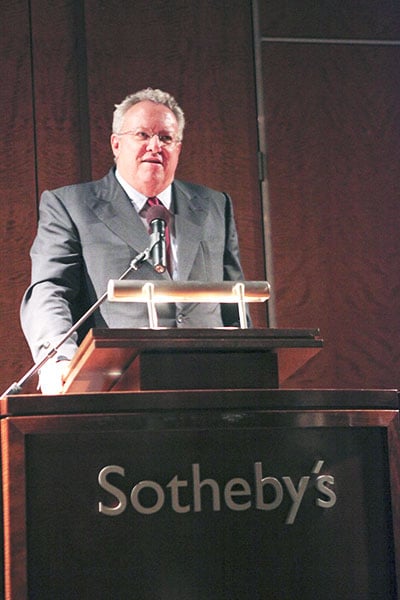Art & Exhibitions
Sotheby’s Third Quarter Private Sales Plummet 61 Percent
Executives insist the trend is temporary.

Executives insist the trend is temporary.

Philip Boroff


Auctioneer Oliver Barker at the rostrom. Photo courtesy of Sotheby’s.
Sotheby’s private sales have dropped by 61 percent in 2014’s third quarter, according to a US Securities and Exchange Commission filing, falling from $390.4 million to $153.5 million. This is unwelcome news given that in the first half of the year they tumbled 48 percent.
For consignors, private sales are a discreet alternative to an auction, where an artwork can publicly flop and get tarnished in the marketplace. For Sotheby’s, private sales offer diversification and have been a longtime source of growth.
In the decade ending in 2013, Sotheby’s private sales quadrupled to $1.2 billion. It hired executives and specialists to oversee them and opened dedicated galleries in New York, London, and Hong Kong. But so far this year, the value of private transactions as a proportion of total sales has dipped to 11 percent from 19 percent in 2013.
Chief financial officer Patrick McClymont tried to accentuate the positive in a conference call yesterday with analysts. He cited a 69 percent increase in the number of private transactions. Although there are fewer “high-value” items—defined by chief executive William Ruprecht as properties above $10 million, both executives insist private sales remain “relevant.”
“We tend to focus on the flow,” Ruprecht said, “so we think of it as a growing and reaffirming point of relevance in the business.”
McClymont said, “We do believe long-term our brand is super relevant in private sales and our expertise is super relevant.”
Blockbuster Auctions at the Expense of Private Sales
The decline hurt an otherwise solid quarter that sent the stock up 5 percent yesterday to $41.45. But with shares down 28 percent from their 2007 peak, the priority for the auction house appears to be staging blockbuster auctions, even at the expense of private sales.
“Christie’s and Sotheby’s profile depend on what goes up at auction,” said Stephane Connery, a private dealer who ran Sotheby’s private sales until 2012. “As a private sales person in the auction business, you have a lot of pressure from your colleagues to feed the auction.”
Ruprecht said on the call that “a small number of trades” of pricey work affect private sales results. “It’s simply an impossible thing to predict how many very high-value transactions you’re going to have,” he said.
In a sign of the importance of private deals, Sotheby’s “incentive compensation” includes amounts specifically awarded to employees for brokering certain private sales, the filing says. For the three months ending in September, incentive compensation expenses fell by a third, to $2.6 million, “resulting from a decline in private sales commission revenues,” Sotheby’s said. As private sales commissions in the quarter dipped 52 percent to $12.4 million, they “largely offset” a $15.7 million increase in auction commissions.
Overall results were aided by cost-cutting and by $4.2 million in insurance that Sotheby’s recovered for expenses associated with its proxy battle against investor Daniel Loeb and the related litigation. Even with the reimbursement, Sotheby’s took a $20.1 million charge related to the fight. In addition to paying its own lawyers and advisers as part of a settlement, it agreed to repay Loeb $10 million for expenses he incurred. That’s not pocket change for the company, whose net income for the first nine months of the year was $44 million.
As for the private sales drop, Connery cautioned that three quarters doesn’t constitute an enduring trend. “It is bloody hard to come by great material,” he said, of securing work for private transactions. “Without the object you’re not going to do the trade.”